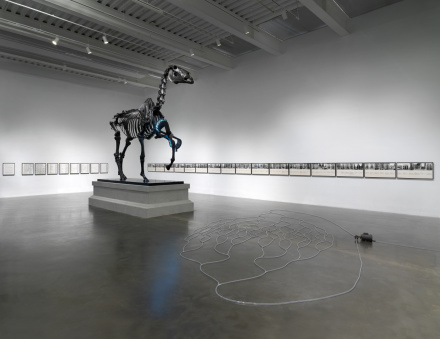
Hans Haacke, All Connected (Installation View), via New Museum
Artist Hans Haacke’s works, ranging from kinetic art to environmental art, conceptual art and institutional critique, culminates in his critiques of social and political systems, orchestrated in masterful form this winter at the New Museum. The retrospective marks the first major American museum exhibition of Haacke’s career, focusing on the influence of the corporate world on contemporary art.
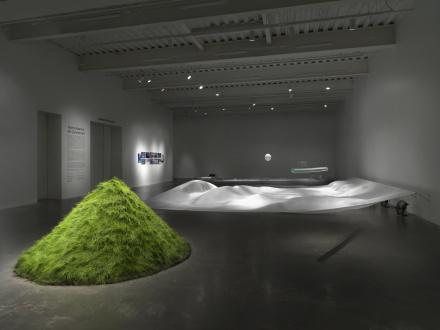
Hans Haacke, All Connected (Installation View), via New Museum
Featuring visitor polls, environmental sculpture and kinetic works, and his unprecedented institutional critiques from the 1970s and ‘80s, and more recent pieces, the exhibition covers thirty years of pioneering works. Exploring the interconnected networks of finance, political agency and power in the art world and outside it, the artist’s works shine a light on spaces and sites where power relations are exposed. This connection is reiterated throughout the exhibition, with many pieces exploring the economic structures in which art is produced, circulated and displayed. The title of the exhibition, All Connected, refers to the kinetic sculptures and environmental sculptures, as well as to the dynamics behind major art institutions and their funding.
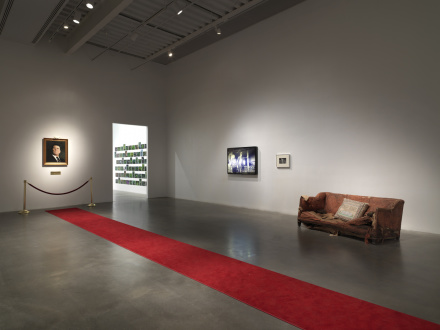
Hans Haacke, All Connected (Installation View), via New Museum
With his works, Haacke brings forward questions on the nature of power in the art world, asking what and who gives value to art. In Seurat’s Les Poseurs (Small Version) (1888-1975) he draws a resume of the various owners in time of a piece by the post-impressionist artist. The account is detailed, specifying where the money used to acquire the pieces is coming from, allowing the viewers to form their own opinion on the artwork and the system as a whole, in particular noting that the work is rarely held outside the hands of wealthy patrons and collectors. The theme recurs in On Social Grease (1975) is a collection of engraved plaques with quotes from business leaders with their reasons for supporting the arts. Other works reflect on the same motif, pointing out museums and institutions accepting funding from corporations whose profits comes from illegal acts or wrongdoing.
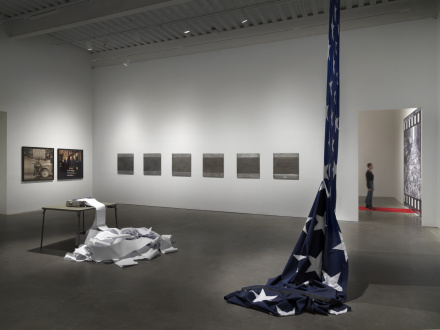
Hans Haacke, All Connected (Installation View), via New Museum
The show also serves as the New York premiere of Haacke’s most recent sculpture, Gift Horse (2014). The bronze sculpture of a horse’s skeleton was originally created by the artist for London’s Fourth Plinth program, filling the famous empty plinth in Trafalgar Square. The horse is adorned with a LED ribbon, streaming stock prices of the location it is shown in. The sculpture calls for a reflection on global capitalism, which links art and finance.
However, Haacke’s critique is directed also to the audience. In Gallery-Goers’ Birthplace and Residency Profile (1969) he uses answers from a poll conducted at the Howard Wise Gallery to track art supporters’ birthplaces and current residences, and includes pictures of the addresses collected. With this data, apparently innocent and apolitical, the artist is questioning the social system behind the public of art shows.
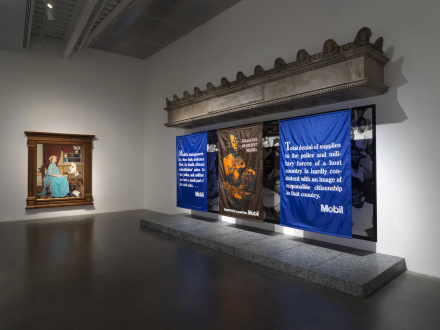
Hans Haacke, All Connected (Installation View), via New Museum
The exhibition devotes the second floor to Haacke’s earlier kinetic art. Rejecting the static model of art and sculpture, the artist combines mundane objects (PVC tubes, sheets, fans) with natural elements such as air, water or ice. Together they create a system connected by normal technologies and in constant transformation, allowing for the work to always be unique. Further, the viewer is part of the system and influences sculptures such as Condensation Cube (1965), a Plexiglas cube filled with water which evaporates and condensate depending on the temperature of the room. Both the viewer and the author have little or no control over the kinetic works, but they influence them as part of a larger system.
On the fifth floor the attention shifts to the polls projects conducted by Haacke since 1969.
Museum-goers can take part in a politically based poll created for this exhibition and smart
displays show the percentage of answered questions. Haacke’s works remain very modern and treat topical subjects, challenging how we think, consume, and produce art. By unveiling the social, political and economic structures of the art world dynamics he proves that indeed all is connected in the relationship between art and society. This retrospective highlights the remarkable and complex work that Haacke has been devoting to for over 30 years, not losing meaning but deepening its complexity with time.
— E. Etrari
Read more:
Hans Haacke: All Connected [Installation View]



